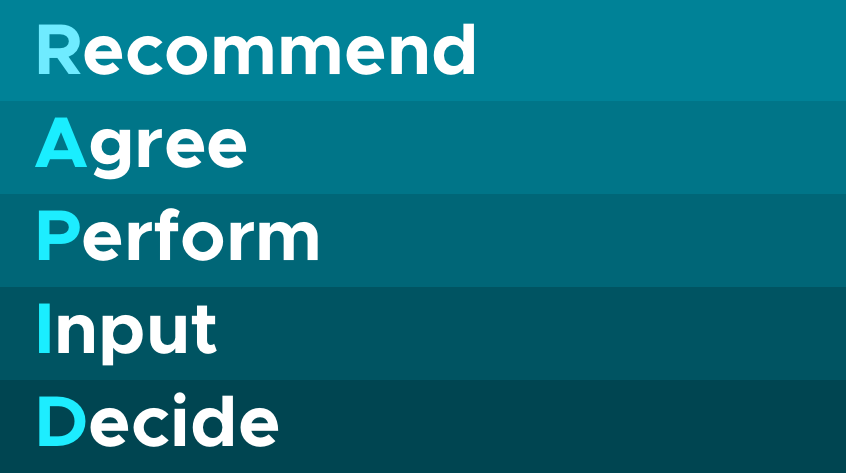Using a decision making framework: a deep dive into RAPID®

I’ve been thinking a lot about operational efficiency and how to build more efficient organizations lately. The velocity of decision making in an organization is at the core of how efficient that organization is overall. If you combine the velocity of decision making with the clarity and accountability required throughout the decision making process, you end up making more good decisions faster.
The more I thought about this, the more I explored different ways to run meetings, write documents, define the rhythm of business, and more. One of the areas that’s been interesting to me is to learn a bit more about decision making frameworks. These are designed to drive transparency into the people behind the decisions. Decision frameworks work best in an environment where there are multiple stakeholders and a balance is needed between a participatory decision making process and the ability to make these decisions quickly and clearly.
Overall, decision making frameworks are designed to make the decision owners and stakeholders clear from the beginning. Throughout the lifecycle of any project, it’s sometimes unclear who owns a final decision, who’s a critical stakeholder, and who’s simply providing input. As discussions go, everyone’s opinion becomes equally valid even if everyone’s responsibility isn’t the same.
As we looked through many decision-making frameworks out there, and there are many of them, we landed on using RAPID® within the design organization at VMware. We’re at the beginning stages of rolling this out across the organization. Other decision making frameworks are as valid and might be better for your organization. That said, using a consistent framework is critical to ensuring your organization is at the same page as you go through building projects in teams.
What is RAPID®?
RAPID® is short for: Recommend, Agree, Perform, Input, and Decision. It is a decision making framework that identifies the key people for each one of these areas and ensures that all people involved are clear on their roles, understand their impact, and have a clear understanding of their ownership and accountability and the ownership and accountability of others on the project.
RAPID® is defined as follows:
- Recommend a decision or action: this is the person or group of people who will participate in recommending an action as part of the expected outcome.
- Agree to the decision or action: this is the person or group of people that must agree to the decision or that their viewpoint, if not fully agreeing, should be reflected in the final proposal and/or outcome.
- Perform the action item: this is the person or group of people responsible for performing the action.
- Input: this is the person or group of people that will provide input. The input may or may not be reflected in the final proposal
- Decide to make a decision: this is the single person who is the decision owner on this. It is really important that there is a single decision owner and not a group of decision owners. If you feel like you’re leaning towards adding multiple people here, you’re probably in need of evaluating your projects and you might find it helpful to split these projects accordingly.
How I am starting to use it
I am starting to use RAPID® in many different contexts. For example, as we do larger end to end experiences that span multiple different products and services and include many different stakeholders, defining RAPID® has been helping to ensure stakeholders are clearly defined into the different levels of RAPID® while having a clear decision maker.
With that in mind, it’s been extremely useful to determine who attends what meetings and who is required for each conversation. For example, a decision owner can decide to collaborate with those falling into the “Agree” group of stakeholders to ensure they’re part of setting the context and making the right recommendations while only showing the final outcome to the group of folks providing input.
I’ve also been using parts of RAPID® as appropriate for smaller tasks. For example, if we have a task out of a staff meeting conversation, we’ve been outlining the needed parts of RAPID® appropriate for that task by highlighting the letter used.
For example, we’ve been working through a project and we needed a clear decision owner and a clear list of who’s needed to agree to the decision. What we did is that we bolded the letters of RAPID® needed as part of our meeting notes with RAPID® meaning the decision owner, and RAPID® meaning the list of people that need to agree to the decision or have their views reflected in it.
Tips to use RAPID®
Using the RAPID® decision-making framework requires discipline and practice. For it to be effective, it requires building the muscle and discipline of thinking through RAPID® at the beginning of each appropriate project. Not every decision requires identifying every aspect of RAPID® clearly.
Note a few tips on using RAPID®:
- If you determine that RAPID® is needed or if it is required as part of a status update, for example, make sure that you identify all aspects of RAPID® before a decision is made or is needed. It is important that people are identified as the project is at its starting point.
- Make sure that recommendations, inputs, and agreements are clearly outlined. Someone who must agree to a decision might also make a recommendation or provide input. It should be clear what level of input are they providing and in what context.
- RAPID® is useful for larger organizations and projects. There are decisions that might benefit from parts of RAPID® (like the decision ownership part) but using it for every single decision is an overkill that could possibly have the opposite effect.
Resources
- Shaping decision style and behavior - a good article on the different decision styles and when to use RAPID®
If you found this useful, you can follow me on Twitter here where I continue to share my journey on how we drive better efficiency around decision making and leadership across our organization.
Thank you to Afifa Tawil for bringing this framework to my attention, reading a draft of this post, and recommending a few resources to add to it.
Note that RAPID® is a registered trademark of Bain & Company, Inc.
My Name Is Jehad Newsletter
Join the newsletter to receive the latest updates in your inbox.

